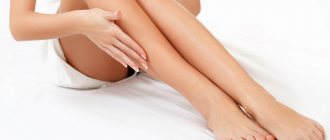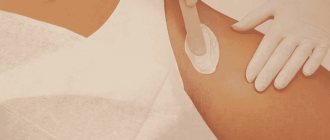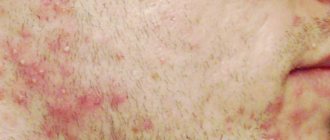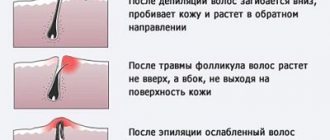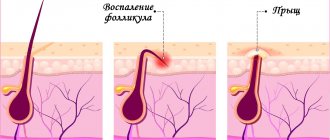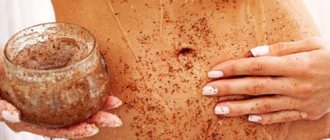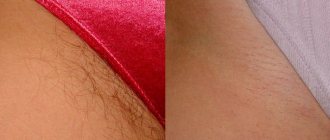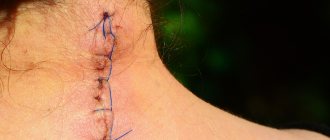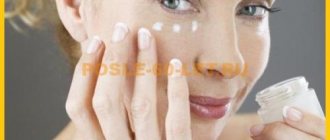Women quite often have to deal with the removal of unwanted hair on their bodies, so ingrown hairs on their legs are a fairly common problem for them. It causes inconvenience to many, although it is quite easy to avoid: this condition occurs in most cases due to violation of removal rules (when they do not pay attention to possible negative consequences), or neglect of preventive measures.
Causes
Ingrown facial hair can affect adults of any age, gender, or race. However, experts have proven that this problem is more common in people who have naturally curly and coarse hair, especially blacks.
Other common causes of ingrown hairs are described below.
Bacterial infection
Such infections cause swelling and suppuration of the hair follicle, which leads to its blockage, causing the hair to grow under the skin.
Staphylococcus aureus is the causative agent of a bacterial infection (folliculitis). It enters the body through cuts and wounds on the skin.
Puberty, pregnancy and menstruation
If hormonal imbalances occur, acne may appear, which prevents normal hair from breaking through the skin.
Many researchers have proven that various causes of acne are directly related to the appearance of ingrown hairs. Acne occurs because hair follicles become clogged with sebum and dead skin cells. For the same reason, hair is forced to grow to the side under the skin, forming ingrown hairs. Therefore, hormonal fluctuations during pregnancy, puberty and menstruation have a lot to do with ingrown facial hair.
In addition, sex hormones can trigger excessive hair growth, which means they increase the likelihood of ingrown facial hair. “People with high levels of certain sex hormones are prone to excessive hair growth, which makes ingrown hairs more likely to occur, especially after shaving.” [Wemd.com]. Despite the fact that it is quite difficult to control this cause, you can seek advice from a doctor who will help normalize hormonal levels.
Other factors that cause acne and ingrown hairs:
- Some medications
- Increased sebum secretion
- Smoking and drinking alcohol
- Follicle contamination
Incorrect hair removal technique
This is one of the main causes of ingrown facial hair. Using poor tools or technique, such as shaving with a dull razor without using shaving gel, or shaving in the wrong direction. All of these can cause razor burns (irritation). It is also necessary to prepare the skin before the procedure and completely clean it after. Instead of waxing, try sugaring.
Laser hair removal
How to get rid of ingrown hairs, what to do if hairs grow ingrown? These questions have always worried and continue to worry the fair sex. The problem of ingrown hairs is now more relevant than ever. There are a great variety of methods for getting rid of unwanted hair on the skin, but most of them cause discomfort, pain, and provoke the appearance of ingrown hairs.
The laser affects the skin inside, specifically the hair follicle, this provokes its destruction and the hair stops growing. This is a quick and painless technique that has now found many fans.
It is best to leave the problem of ingrown hairs to a specialist, so you can avoid infection, infection and other unpleasant consequences.
Symptoms
Swollen, infected ingrown hairs
Ingrown hairs cause psychological discomfort because they have an unflattering appearance. This is especially true if the problem is in open areas of the body. The main symptoms of ingrown hairs appear a few days after the hair removal procedure. Among them:
- Small blisters that ooze pus
- Pain and itching
- Inflammation, redness, skin sensitivity
- Small, hard papules
- Darkening of the skin
- Razor burns
- Ingrown hair cyst
- Significant swelling
Many of the symptoms mentioned above indicate that an ingrown hair infection has occurred. All symptoms should be eliminated immediately to avoid further scarring.
Deeply ingrown facial hair
Consequences of deeply ingrown hair
The main reason for the appearance of deeply ingrown hair is the wrong technique for removing them, most often this concerns waxing . This condition causes considerable discomfort and pain. Solving this problem will require professional intervention. Additionally, there are several products that can be used at home to treat this condition.
In any case, it is better to prevent the development of ingrown hairs by following simple recommendations than to treat them.
Healtreatcure.org suggests that "creams containing lactic acid can help soften the skin to make hair growth easier." Remember that such creams also help treat scars due to ingrown hairs.
Ingrown hairs: folk remedies
- Dip a cotton swab into the witch hazel infusion and apply to areas of the skin where there are ingrown hairs. This home remedy soothes the skin and helps remove hair. In addition, witch hazel infusion relieves redness and inflammation, exfoliates dead skin cells, moisturizes it and opens pores. Use it before and after waxing.
- Pry out the ingrown hairs with tweezers. After all, they “hide” under the top layer of the epidermis, and therefore they need to be removed delicately, slightly prying the skin. Gently lift the hair, but do not pull it out, as this can lead to infection. Do not forget that this procedure must be performed with clean hands washed with soap. While tweezers must be pre- treated with alcohol or hydrogen peroxide.
- Aloe vera gel is a natural remedy to combat ingrown hairs. Use it daily, at night. Aloe-based creams and lotions are also suitable for this purpose, but they are less effective. Just make sure that they do not contain alcohol, otherwise it will irritate your already damaged skin.
- Essential oils. chamomile or lavender oils are great . Be careful, some oils cannot be applied to the skin in their pure form. This may cause burns. If necessary, thin them with olive oil or sweet almond oil. You can mix several oils to enhance the effect.
How to get rid of it?
Sometimes ingrown hairs will go away on their own, but there are steps you can take to speed up the healing process and prevent large bumps from forming.
If the hair does not break through for a long time, it can continue to grow under the skin, reaching impressive sizes.
- One of the most common ways to remove a single ingrown hair is to use sharp tweezers or a sterile needle. There usually comes a time when the loop of hair is very close to the surface, then you can try to grab it and pull it out. You need to pull out the hair completely, if possible.
- If the ingrown hairs are still deep, then you can help them. Place a hot compress on the area. The heat will soften the skin and help bring the hair closer to the surface. In many cases, one such compress will be enough to make it possible to grab them with tweezers.
- As an alternative to a hot compress, you can use a good folk remedy (judging by reviews on foreign forums) - bread soaked in hot milk. It is also applied to the problem area of the face.
- You can try to remove ingrown facial hair only when it is under the surface of the skin, or begins to emerge from it with a tip or loop. It may take a while for the curly hair to get closer to the surface, just don't pick at the skin.
- It is not always worth trying to remove ingrown hair, especially since this is not always possible at home. If you carry out proper treatment and care, then over time everything should go away.
Chemical depilation
Chemical depilators will not only get rid of unwanted body hair, but also eliminate ingrown hair on your legs, bikini area and other places. Special products in the form of lotion or cream are applied to the skin, they have a destructive effect on the hair structure, and subsequently the hair falls out. The hair is completely destroyed, not just the outer part, so the skin looks smooth, healthy and shiny. The same cannot be said about shaving. With this method of hair removal there is no pain and no blackheads remain.
To prevent ingrown hairs when using this method, it is imperative to apply exfoliating products first, thereby giving the hair a path to grow in the future so that it does not curl.
Treatment
It is quite possible that an infection may occur. The type of treatment depends on the presence of infection and the stage of the disease. Some of the effective treatments for ingrown facial hair will be discussed below.
External means
If you have a minor infection, you can treat it with both over-the-counter medications and those that are available only with a doctor's prescription. Among them, the main drugs are corticosteroid, antibiotic and retinoid ointments and creams.
These medications, especially corticosteroids, help relieve inflammation caused by ingrown hairs. The use of creams on the affected skin always alleviates the condition and speeds up the healing process.
On the other hand, retinoid creams help get rid of dead skin cells, therefore simplifying the process of hair growth. Some medications may only be available with a doctor's prescription.
Preparations for oral administration
These medications are very effective, especially in cases of serious infection. Severe cases of ingrown facial hair may require oral antibiotics.
This medication also helps fight staph, a bacterial infection that occurs whenever hair follicles become clogged and inflamed. Please note that if timely treatment does not work, the inflammation can develop into a serious infection such as cellulitis.
Changing your facial routine
Another great way to deal with ingrown facial hair is to change up some of your beauty routines. For example:
- First of all, you need to maintain an interval of several weeks between hair removal procedures.
- It is also recommended to cleanse the skin with a scrub once a week to facilitate hair growth.
- For shaving, use only very sharp blades.
- Shave in the direction of hair growth.
Electrolysis and laser treatment
Electrolysis as well as laser hair removal can be very effective because they destroy the hair follicle, causing hair growth to slow down and, after a while, stop completely. These treatments also help limit scarring caused by ingrown hairs.
During the electrolysis procedure, small current discharges are sent through the hair to its root, which destroys the hair follicle.
Causes and symptoms of lump formation
The likelihood of a cyst forming depends on where and for how long the ingrown hair has been bothering you. The more time it remains under the skin, the longer it becomes and the more it curls.
Under the skin, the ingrown hair continues to grow and can sometimes reach enormous sizes. If it does not break through the skin, but curls further, this increases the risk of cyst formation
Staphylococcal infection
An extremely painful lump indicates an infection. An infected cyst can be caused by various reasons. One common cause of an infected lump is touching, squeezing, piercing, or self-cleaning with dirty sharp objects.
It can grow in various areas, including the scalp, face, armpits, and groin area. An infected ingrown hair usually starts out as a small or large pimple.
If you have a bacterial or staph infection, it will lead to the accumulation of yellowish or greenish pus, tender bumps that may become red and hot. Untreated staph infections can lead to abscesses and boils characterized by a bad odor.
On the face and chin
Shaving or removing facial hair improperly can also cause bumps. The hair cannot penetrate the skin and thus becomes curled underneath it. This usually occurs when men shave their beard against the direction of hair growth, too close to the skin, or when individual hairs are pulled out with tweezers. Women who remove hair with wax may also be susceptible to hair formation.
They are usually painful and can become irritating when you touch or try to squeeze them out. Once the ingrown hairs thicken, they turn into cysts because touching them can cause them to become infected.
It is recommended to see a doctor before the infection spreads, which can lead to serious cysts on the face. You should be careful and never try to remove hair using tweezers. Otherwise, regular exfoliation of the skin, especially areas with hair growth, can be done.
On the neck
Hair growing around the neck is curly in nature. “People with curly hair are more likely to suffer from pseudo-folliculitis than those with straight hair” [livestrong.com]. Besides shaving, bumps can be caused by bacterial or staph infections.
If medications are not used to kill bacteria and treat infections, they can become serious. Statistically, adult men are at higher risk of developing neck cysts than anyone else.
In the pubic area
Bumps around ingrown hairs can also develop near the pubic bone, although this is not as common. One of the undeniable facts is that a large amount of hair usually grows in this area in adults (men and women alike). The main cause of lumps between the anus and vagina (for women) or on the testicles is infection. Trying to get rid of ingrown hairs in your bikini area may be responsible for this.
Common signs that accompany bumps are redness, tenderness, inflammation and itching, discomfort and sometimes pain. They mostly resolve on their own. However, once infected, they can develop into cysts deep under the skin, producing pus that is usually yellow or green (also called papules or pustules).
Ingrown hairs and bumps on legs
Ingrown hair abscess on a woman's leg
Another area susceptible to ingrown hairs is the legs and inner thigh, especially the upper thigh (groin area).
In addition to removing hair through shaving, this problem can occur as a result of activities such as riding a bicycle or riding a horse. During activity, there is constant friction between the saddle and the surface of the inner thighs. When the friction force becomes high, the skin becomes inflamed. If the thighs have been shaved, the skin swells. At this stage, small bumps (pseudofoliculitis) form, allowing the ends of the hair to curl easily inside.
These cysts are usually small and cause pain during activities such as walking, exercise and cycling.
A more or less similar case may occur among women who are accustomed to resorting to waxing. When hair begins to grow along the bikini line, the hair follicles shrink. If an infection occurs, bumps can easily develop in this area. This problem affects both men and women.
Pilonidal cyst (tailbone cyst)
Sometimes you may wonder what can cause pain in the lower spine or tailbone? “Pilonidal” means “nest of hair,” which is why doctors believe it is due to ingrown hairs around the skin covering the tailbone. Men suffer more from pilonidal cysts, but women can also develop them.
According to WebMD, a pilonidal cyst around the anus and vagina is considered an abscess, which is a “tender mass usually surrounded by a pink to dark red area of skin,” or boil. You should get checked if swelling occurs above the anus. Other symptoms include:
- Pain near the tailbone
- Edema
- Discharge of pus, which may have a foul odor
- Fever, etc.
Once examined by a doctor, a surgical drainage or marsupialization procedure will be required to remove it along with the ingrown hair. (If it turns out that antibiotics are less effective). The wound that will be received will require a lot of attention, which means that hygiene must be carefully monitored. Pilonidal cysts tend to recur. In this case, you should consult your doctor again.
Ways to Prevent Ingrown Hairs
To prevent the appearance of ingrown hairs, you can use different methods. Here are the main ones:
Home Remedies
They can be used to soften the skin and remove excess sebum and dead skin cells. To do this, you can use sugar and baking soda as a scrub, as well as tea tree oil, aspirin, aloe vera, egg white, black tea bags, salt and others.
These products make ideal scrubs, masks and absorbent pore strips that cleanse your facial skin and prevent inflammation and ingrown hairs.
Correct ways to remove hair
Proper removal of excess hair will also help prevent the problem of ingrown hairs:
- Shave in the right direction, that is, in the direction of hair growth.
- Use only sharp blades and boil the razor after each procedure to avoid inflammation.
- Don't try to shave everything perfectly smooth. This increases the risk of skin damage and, as a result, ingrown hairs.
- Prepare your skin before shaving.
- Sterilize hair removal tools before using them.
- Do not try to remove ingrown hair with dirty hands.
Daily care
Be sure to wipe your face with a wet cotton cloth daily. You can also use exfoliating scrubs to ease the regrowth of ingrown hairs. Use chemical or homemade products, but remember that over-exfoliating can damage your skin!
How to avoid ingrowth?
There is no solution to the problem of ingrown hairs as such. There are only a few steps you can take to help reduce the likelihood of a problem occurring.
Important Tips:
- let go of your beard: neatly trimmed stubble will avoid the need to constantly shave, which will remove the most important factor that provokes the formation of ingrown bristles;
- Before shaving, be sure to use a scrub, which must be rubbed with massage, circular movements into the surface of the face for 2-3 minutes;
- Be sure to prepare your facial skin for hair removal by steaming it, using appropriate cosmetic products, and soothing the skin after the procedure;
- in order to soften the hard structure of the hair, you can wash it before shaving with hot water and soap;
- use devices that have only one blade, promptly replace a dull tool;
- shave your face in one pass, moving the razor from the cheeks to the jawline;
- Shave your neck also in one movement, moving upward, towards the jawline;
- move the blade over one area only once;
- avoid strong tension on the skin while manipulating the razor.
If the above methods do not give a positive result, you can use chemical depilators to remove hair. Their use requires caution; many cause serious allergies and irritation of the surface of the face. Chemical products are not suitable for daily use.
As an alternative to the machine, you can use a shaving machine; it does not cut the shafts so short. An electric razor is not suitable for this purpose; it gives the same effect as multi-blade razors.
Ingrown beard hairs are a common occurrence that can be difficult to get rid of. However, every man is fully capable of preventing the development of the problem; the main thing is to organize proper facial skin care and carry out the shaving procedure strictly according to the rules.

